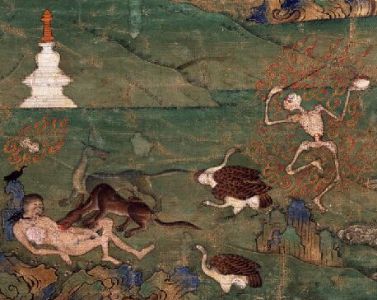
Subject: Charnel Grounds & Cemeteries
Mandala Main Page Subjects, Topics & Types:
Subjects, Topics & Types:
- Description (below)
--- Eight Great Cemeteries
--- Sixteen Great Cemeteries
--- Eight Gods
--- Eight Siddhas in the Cemeteries
- Study Guide
- Cemeteries Outside Mandala
- Pitha Locations
- Purelands & Sacred Geography
- Masterworks
- Confusions
- Others...
Videos:
- Cemeteries: An Overview
- Eight Gods of the Cemeteries
- A Question on Cemeteries
- Sixteen Cemeteries
- Charnel Grounds & Geographic Locations (HAR on Patreon [10 min.])
Charnel Ground: Indian cemeteries (श्मशान. śmaśāna) where bodies are deposited. The Tantric texts that describe wrathful deities also describe wrathful venues for their practice. Charnel grounds are the most fearsome and abhorrent places in India. Wrathful deities are therefore associated with charnel grounds and peaceful deities are associated with pleasant and beautiful surroundings. (See Eight Great Charnel Grounds). Tantra source text: shmashanalankara-tantraraja.
Cemeteries in Art:
- Wrathful deity & wrathful offering paintings
- Siddha Appearance paintings
- Outer circle for semi peaceful/wrathful & wrathful deity mandalas (Shmashanalankara-tantraraja)
Eight Great Charnel Grounds: according to Tantric literature and the descriptions of wrathful deities and their environments, the eight charnel grounds surround the central palace and deity. There are several different sets of eight names and descriptions for the eight great charnel grounds depending on the Buddhist and Hindu Tantric literature consulted. These charnel grounds also have physical locations in India such as the Laughing charnel ground at Bodhgaya and the Cool Grove charnel ground close by, along with the Frightening charnel ground in the Black Hills of Bihar.
From the Hevajra Tantra literature: "In the east is the Gruesome charnel ground (chandograkatasi); south Frightful with Skulls (bhairavakapalika); west Adorned with a Blazing Garland (jvalamalalankara); north Dense Jungle (girigahvaronnati); north-east Fiercely Resounding (ugropanyasa); south-east Forest of the Lord (ishvaravana); south-west Dark and Terrible (bhairavandhakara); north-west Resounding with the Cries Kili Kili (Kilikilaghoshanadita). Furthermore, there are headless corpses, hanging corpses, lying corpses, stake-impaled corpses, heads, skeletons, jackals, crows, owls, vultures, and zombies making the sound, "phaim". There are also siddha with clear understanding, yaksha, raksha, preta, flesh eaters, lunatics, bhairava, daka, dakini, ponds, fires, stupa, and sadhaka. All of these fill the charnel grounds." (Konchog Lhundrub 1497-1557, written in 1551). (See painted example). (See Charnel Ground).
In the Chakrasamvara cycle of Tantra the Eight Great Charnel grounds are: east Gruesome, north Dense Wild Thicket, west Blazing with [the Sound] Ur Ur, south Terrifying, south-east Marvelous Forest, south-west Interminably Gloomy, north-west Resounding with the Sound Kili Kili, north-east Wildly Laughing. These names are extracted from a Chakrasamvara ritual text composed by Chogyal Pagpa).
A common Nyingma list: east Cool Grove, south Perfected in Body, west Lotus Heap, north Lanka Heap, southeast Spontaneously Accomplished Heap, southwest Play of the Great Secret, northwest Pervasive Great Happiness, northeast World Heap.
Sixteen Charnel Grounds: In the Kalachakra Tantra system sixteen charnel grounds are described. The 634 Deity Kalachakra Mandala, being only slightly wrathful, generally does not appear with any surrounding charnel grounds. However, the Mahasamvara Kalachakra always appears in paintings surrounded by the sixteen charnel grounds. These eight or sixteen can appear either immediately surrounding the Celestial Palace of the deity and retinue or they can appear as the outer ring of the mandala. The root Tantras are vague on this subject of charnel grounds and it is the Indian Sanskrit commentaries that explain the different ways that the cemeteries can be imagined and subsequently depicted in visual representations.
In the Tantric Buddhist classification of Anuttarayoga, according to one system, the Eight Direction Gods of the Cemeteries are:
1. Shakra on an elephant, east,
2. Yama on a buffalo, south,
3. Varuna on a makara, west,
4. Yaksha on a horse, north,
5. Ishana on a bull, north-east,
6. Agni on a goat, south-east,
7. Rakshasa on a zombie, south-west,
8. Vayu on a deer, north-west.
The eight cemetery guardians/gods are the same as the - Ten Gods, Guardians of the Ten Directions with two of the gods, Brahma and Bhudevi, omitted.
Jeff Watt 8-2009 [updated 5-2020, 1-2021]
Toh 402. The Tantra of the Ornament of the Charnel Ground. དུར་ཁྲོད་རྒྱན་གྱི་རྒྱུད། · dur khrod rgyan gyi rgyud. śmaśānālaṃkāratantra.
The Glorious King of Tantras That Resolves All Secrets (Toh 384)
1.15. Symbolizing the absence of conceptuality about an ordinary universe and inhabitants,
The eight charnel grounds
Should be arranged to left and right in order.
1.16. The concepts related to each feature, moreover,
Should be learned from a master’s oral instructions.
1.17. Symbolizing the power of the antidote fully developed,
Trees are continuously arranged in sequence.
The directional protectors are arranged as symbols
For the overcoming of concepts oriented toward the ten non-virtues.
1.18. The eight nāgas are stationed
To destroy the wicked ones
Of attachment, hatred and ignorance.
1.19. Rain clouds are arrayed
So that body and speech may act for the welfare of beings,
With divine pride in the two form buddha bodies
Endowed with great compassion.
1.20. Inner and secret are the same.
Likewise, as for the ultimate, the fourth,
One should learn the oral tradition.
(Toh 384. The Glorious King of Tantras That Resolves All Secrets.
དཔལ་གསང་བ་ཐམས་ཅད་གཅོད་པའི་རྒྱུད་ཀྱི་རྒྱལ་པོ། · dpal gsang ba thams cad gcod pa’i rgyud kyi rgyal po
Śrīguhyasarvacchindatantrarāja). 84000: Translating the Words of the Buddha.
(The images below are only a selection of examples).












